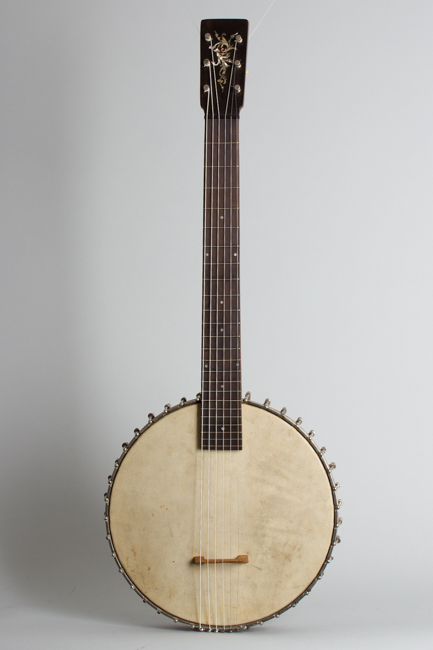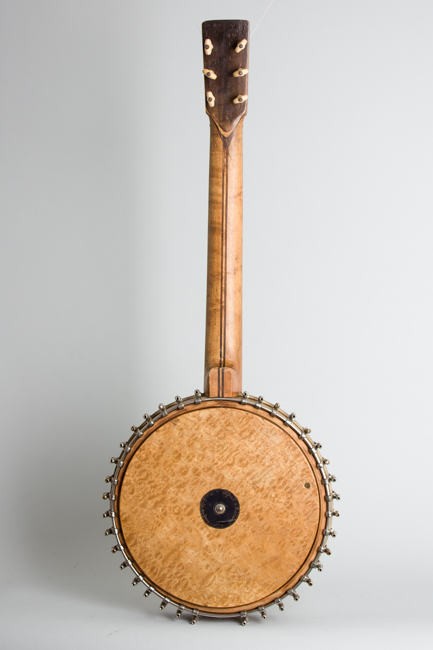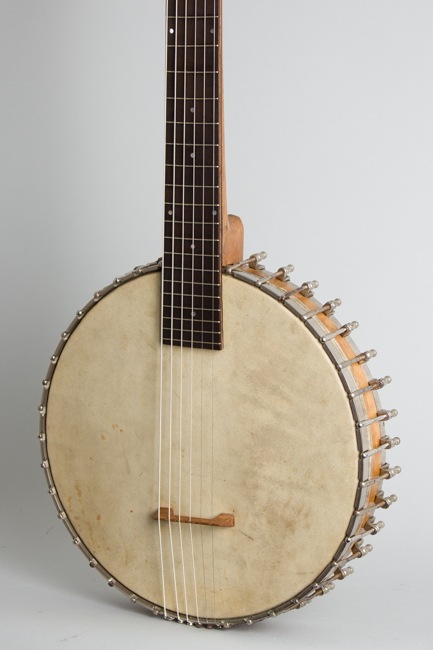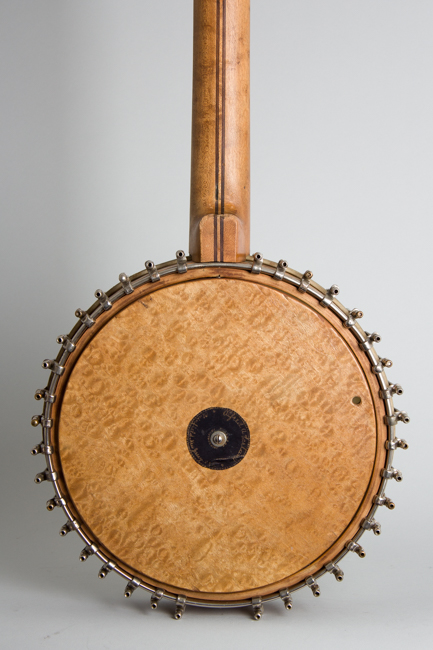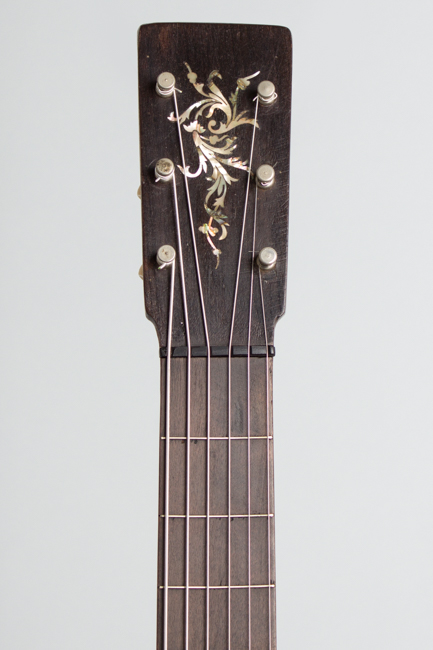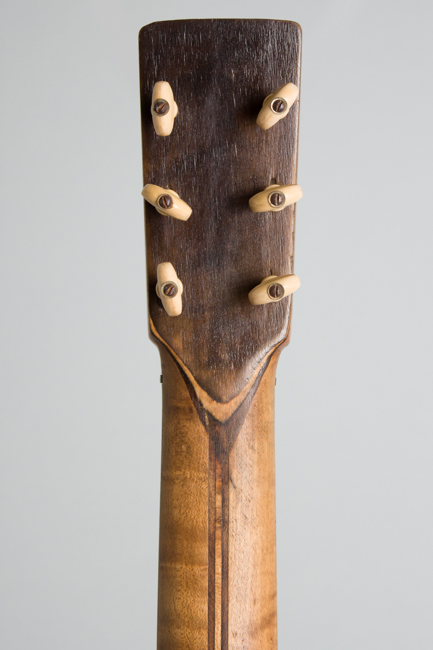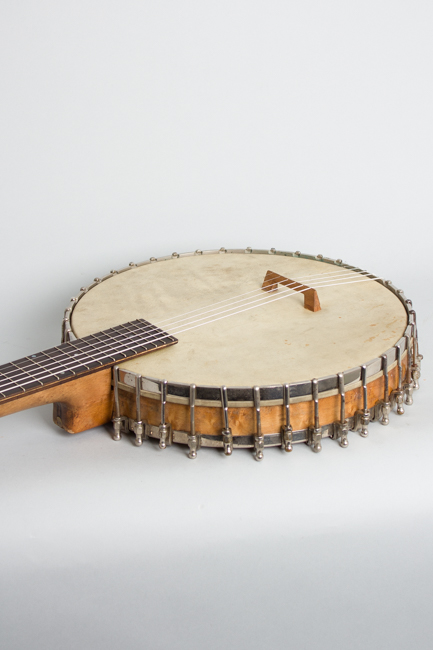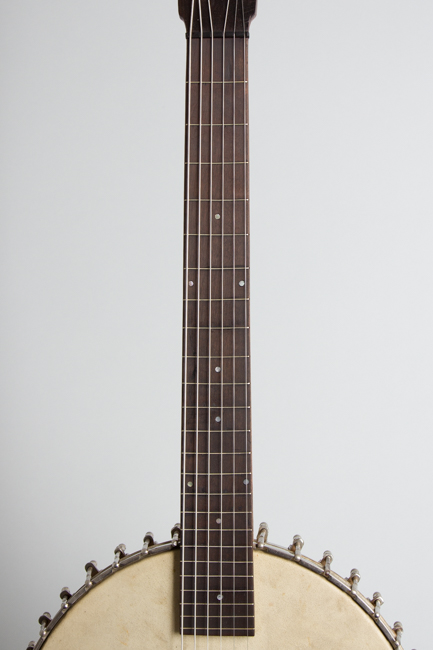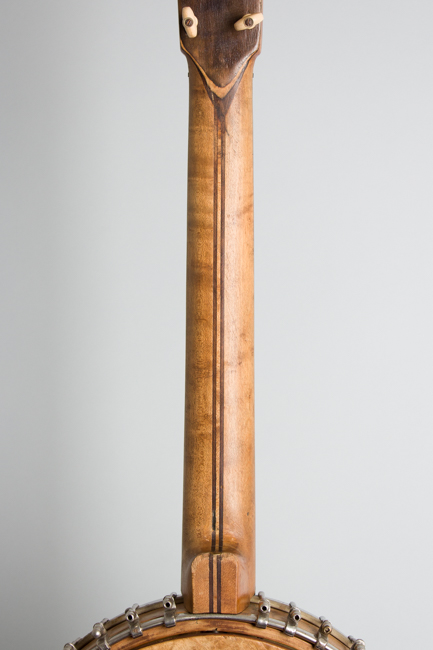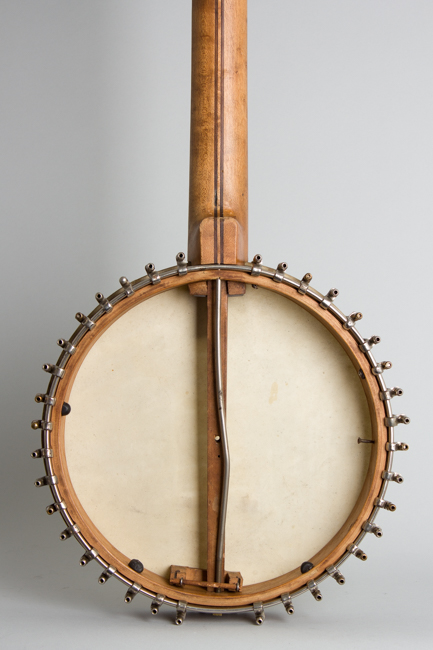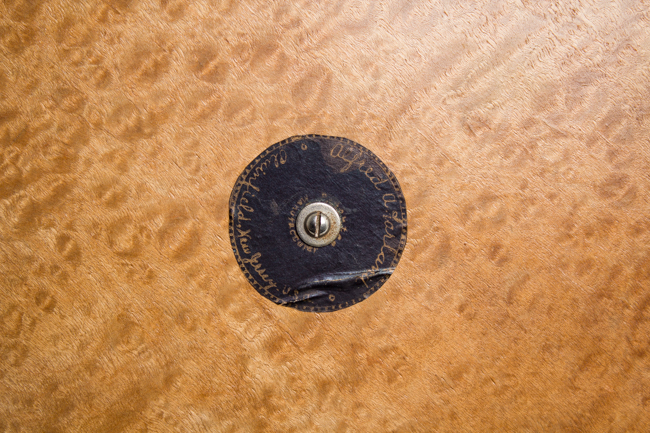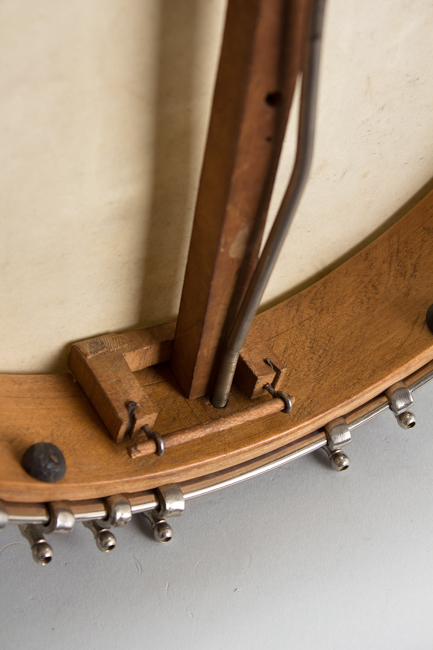A. A. Farland Guitar Banjo , c. 1900
This item has been sold.
Item # 9956
Prices subject to change without notice.
A. A. Farland Guitar Banjo, c. 1900, made in Plainfield , New Jersey, natural varnish finish, laminated maple neck and rim, ebonized maple fingerboard, molded black plastic hard shell case.
This is one of the odder banjo instruments we have seen in a long time, not only the earliest Farland-labeled banjo we ever encountered, but in 6-string guitar format to boot. We have never seen another Farland this primitive; it looks like the parts were made in a factory and then crudely hand-finished before assembly into an instrument. Rettberg & Lange would be the obvious suspects for supplying the components, although in the time frame this banjo would have been made they were a young operation. It is quite possible Alfred A. Farland assembled this piece himself in his shed in Plainfield New Jersey.
Alfred A. Farland was not a luthier, but a well-known banjo virtuoso of the late nineteenth century. He didn't care for those new-fangled tone rings everyone was using on their fancy instruments, pontificating on their "tinny!" sound. He also didn't like spun-over metal rims, like those on S.S. Stewart's banjos, for the same reason. So, he designed his own banjos with no tone ring whatsoever - just a wood rim sloped away from the edge. He called it the "A.A. Farland Beveled Top Wood Rim Banjo", putting a label inside to that effect with his picture in the center.
This is a very unusual banjo, with some interesting design features and workmanship ranging from excellent to surprisingly crude. The neck laminated maple with triple contrasting center-strips and a large heavy heel. The headstock has multiple ebonized veneers front and back with contrasting wood underlays and a fancy cut pearl design inlaid into the face. The ebonized fingerboard has wood underlay, delicate tiny pearl dot inlays and an ebony nut. The carving work where the back of the headstock joins the neck is the crudest we have ever seen on a production instrument of this quality; we wound assume this was made from a factory blank by someone not a skilled woodworker. The heel is better, but also fairly clunky in profile. The original friction tuners are still intact.
The rim is even more eccentric. laminated birdseye maple with an ebony cap, which has a marquetry center strip. The dowel is similarly appointed, and bears a label marked with Farland's signature and claiming manufacture in Plainfield, New Jersey. There is an elaborate and fascinating mute assembly mounted on the dowel with a string-and-turnbuckle connection to a small lever on the rim, another Farland invention. This is intact but not currently adjusted to actually mute the banjo. In practice it is actually rather inconvenient as it works in reverse to most such systems, being permanently engaged unless the lever is pressed to un-mute the instrument!
This superb and very fancy Farland banjo is not only a beautiful example of turn-of-the-century craftsmanship but a distinctive sounding instrument. Farland's ideas were regarded even at the time as eccentric and didn't ever catch on in a big way, but he did leave behind some elegant and distinctive banjos. The unique sound of the beveled top wooden rim gives the banjo a deeper mellow tone prized most famously by John Hartford, among others. Some makers have even copied them in more recent times. This all-original Artists Grand is a beautifully preserved and excellent playing example of Farland's legacy.
Overall length is 34 1/4 in. (87 cm.), 12 3/8 in. (31.4 cm.) diameter head, and 2 5/8 in. (6.7 cm.) in depth, measured at side of rim. Scale length is 24 in. (610 mm.). Width of nut is 1 7/8 in. (48 mm.).
This instrument shows signs of long use and general wear, but is a fully playable eccentricity at least. The so-thin-as-to-be almost non-existent oil varnish finish is worn and stained, almost completely worn off the back of the neck. There are dings, dents and scrapes overall. There is some damage and chipping to the heel, but the rest of the instrument is intact and, as far as we can tell, fully original. The mute is not mounted. The very thin wire frets are original, that have been trued up to make this instrument fully playable. Set up with an old (period?) skin head and LaBella banjo silk-wound guitar strings this is a charming oddball of an instrument, with a unique dark and plunky old-time tone. Very Good + Condition.
This is one of the odder banjo instruments we have seen in a long time, not only the earliest Farland-labeled banjo we ever encountered, but in 6-string guitar format to boot. We have never seen another Farland this primitive; it looks like the parts were made in a factory and then crudely hand-finished before assembly into an instrument. Rettberg & Lange would be the obvious suspects for supplying the components, although in the time frame this banjo would have been made they were a young operation. It is quite possible Alfred A. Farland assembled this piece himself in his shed in Plainfield New Jersey.
Alfred A. Farland was not a luthier, but a well-known banjo virtuoso of the late nineteenth century. He didn't care for those new-fangled tone rings everyone was using on their fancy instruments, pontificating on their "tinny!" sound. He also didn't like spun-over metal rims, like those on S.S. Stewart's banjos, for the same reason. So, he designed his own banjos with no tone ring whatsoever - just a wood rim sloped away from the edge. He called it the "A.A. Farland Beveled Top Wood Rim Banjo", putting a label inside to that effect with his picture in the center.
This is a very unusual banjo, with some interesting design features and workmanship ranging from excellent to surprisingly crude. The neck laminated maple with triple contrasting center-strips and a large heavy heel. The headstock has multiple ebonized veneers front and back with contrasting wood underlays and a fancy cut pearl design inlaid into the face. The ebonized fingerboard has wood underlay, delicate tiny pearl dot inlays and an ebony nut. The carving work where the back of the headstock joins the neck is the crudest we have ever seen on a production instrument of this quality; we wound assume this was made from a factory blank by someone not a skilled woodworker. The heel is better, but also fairly clunky in profile. The original friction tuners are still intact.
The rim is even more eccentric. laminated birdseye maple with an ebony cap, which has a marquetry center strip. The dowel is similarly appointed, and bears a label marked with Farland's signature and claiming manufacture in Plainfield, New Jersey. There is an elaborate and fascinating mute assembly mounted on the dowel with a string-and-turnbuckle connection to a small lever on the rim, another Farland invention. This is intact but not currently adjusted to actually mute the banjo. In practice it is actually rather inconvenient as it works in reverse to most such systems, being permanently engaged unless the lever is pressed to un-mute the instrument!
This superb and very fancy Farland banjo is not only a beautiful example of turn-of-the-century craftsmanship but a distinctive sounding instrument. Farland's ideas were regarded even at the time as eccentric and didn't ever catch on in a big way, but he did leave behind some elegant and distinctive banjos. The unique sound of the beveled top wooden rim gives the banjo a deeper mellow tone prized most famously by John Hartford, among others. Some makers have even copied them in more recent times. This all-original Artists Grand is a beautifully preserved and excellent playing example of Farland's legacy.
Overall length is 34 1/4 in. (87 cm.), 12 3/8 in. (31.4 cm.) diameter head, and 2 5/8 in. (6.7 cm.) in depth, measured at side of rim. Scale length is 24 in. (610 mm.). Width of nut is 1 7/8 in. (48 mm.).
This instrument shows signs of long use and general wear, but is a fully playable eccentricity at least. The so-thin-as-to-be almost non-existent oil varnish finish is worn and stained, almost completely worn off the back of the neck. There are dings, dents and scrapes overall. There is some damage and chipping to the heel, but the rest of the instrument is intact and, as far as we can tell, fully original. The mute is not mounted. The very thin wire frets are original, that have been trued up to make this instrument fully playable. Set up with an old (period?) skin head and LaBella banjo silk-wound guitar strings this is a charming oddball of an instrument, with a unique dark and plunky old-time tone. Very Good + Condition.
